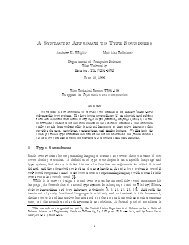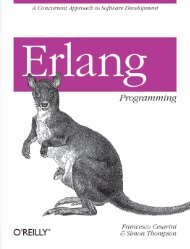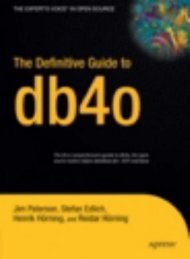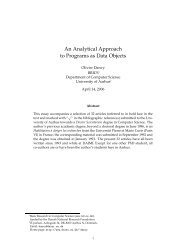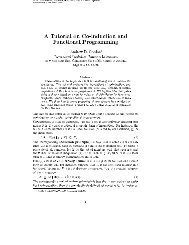The TASM Language Reference Manual Version 1.1 - Synrc
The TASM Language Reference Manual Version 1.1 - Synrc
The TASM Language Reference Manual Version 1.1 - Synrc
You also want an ePaper? Increase the reach of your titles
YUMPU automatically turns print PDFs into web optimized ePapers that Google loves.
proj<br />
name<br />
desc<br />
Figure 3.3: XML Syntax Tree for Project (proj) Node<br />
Table 3.4: XML Tags for Project (proj) Node<br />
Tag Type Meaning<br />
name Attribute <strong>The</strong> name of the Project<br />
desc Attribute <strong>The</strong> description of the Project<br />
these nodes, in turn, has a one-to-many relationship to subnodes that have definitions<br />
for individual types, resources, and variables.<br />
An example of the XML for an environment with two user-defined types, two variables,<br />
and one resource is given in XML example 2.<br />
<strong>The</strong> System node (sys) is used to describe the set of main machines that are executing,<br />
their instantiation, and the initial values of variables in the environment. <strong>The</strong><br />
core idea between the ”system” is a ”configuration”, which denotes a specific instance<br />
of the machine templates and initial values in the environment. <strong>The</strong> idea is that those<br />
”configurations” could be saved, named, and selected when doing simulation. In future<br />
versions of the language, configurations could be extended to include concurrency semantics<br />
and other ”selectable” behavior during simulation. <strong>The</strong> sys node has only one<br />
children node that holds the list of configurations (the confs node). <strong>The</strong> confs node<br />
has a one-to-many relationship with conf nodes that each contain a configuration definition.<br />
Each configuration includes a name (the cname attribute), a description (the<br />
cdesc attribute), and initial values for environment variables (the vinits node), and<br />
machine instantiations (the minits node). <strong>The</strong> syntax tree is shown in figure 3.5 and<br />
the tag descriptions are explained in table 3.6.<br />
An example of the XML for an system with a single configuration is shown in the<br />
XML example 3.<br />
<strong>The</strong> Templates node (tmpls) is used to describe the set of machine templates that<br />
are available to be instantiated in the system. <strong>The</strong> tmpls node has as many children<br />
nodes as there are templates. <strong>The</strong>re are three different types of templates - Main machine<br />
templates, Sub machine templates, and Function machine templates. Each type<br />
of template has roughly the same syntax, which are shown separately. <strong>The</strong> syntax tree<br />
for the top level skeleton of templates is shown in figure 3.6 and the tag descriptions<br />
are explained in table 3.7.<br />
<strong>The</strong> different syntax for individual template types is explained in subsequent sections.<br />
An example of the XML for a list of templates with 2 Main machines, 1 Function<br />
machine, and 1 Sub machine is shown in XML example 4.<br />
50




